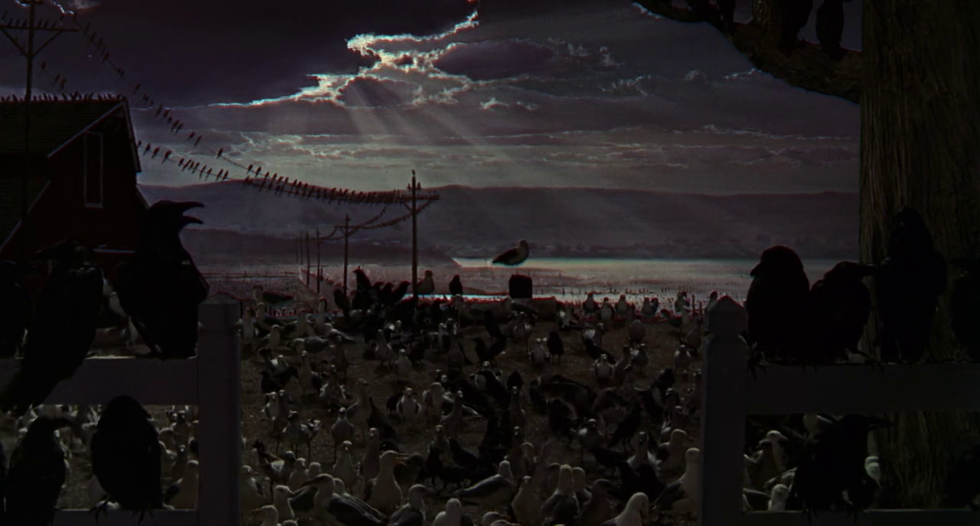In my ninth grade English class, we read Daphene du Maurier’s novelette The Birds. In short, The Birds is about one frightful winter’s night when all the birds in England, potentially the rest of the world, attack, and the struggle of one man to protect his family. When thinking about all the horrors one could face in an end of the world type scenario, birds do not seem that scary. Compared with alien invaders, giant lizard monsters, or nuclear war, an apocalypse brought about by birds seems almost laughable. Wrong! The Birds is the scariest story I have ever read. Think about all the birds you see on a daily basis. All the robins, the wrens, or the pigeons walking around in busy streets. Think about how many bird calls you hear in the morning, between the chickadees, the blue jays, or even the frustrating wrapping of wood peckers. At this point in our mental journey, you are picturing quite a few birds. Now, think about all the birds you do not see in your area. Think about the gulls that spend most of their day out farther over the water, or the hawks that deeper in the woods, or even smaller orioles that just miss your eye. There are so many birds on this planet, and one day they will decide to join forces and kill us all. Luckily for all readers of this, I have recently reread The Birds and have compiled a handy guide for how to survive the inevitable bird apocalypse.
1. Warning Signs
In du Maurier’s novelette, the attack of the birds coincides with the coming of the east wind and the brutal start to winter. While it is the main character’s belief that this sudden severe change in weather is what has led to the avian assault, I am not willing to state that correlation equals causation. Just because we are in the summer months here in the United States does not mean we are perfectly safe. The sign of impending fowl doom is nigh rests in the behavior of the birds. It will start with the gathering. While it is normal to see a couple to a couple dozen birds sitting on telephone wires, hundreds will now take up the space. Birds will pack so tightly together, leering on the wires, that a pin will not fit between their heads, and the wires will start to sag under the weight, making passer-bys wonder if they will break. On the shores, gulls of all varieties will circle above the waves, rising and falling with the air currents. The formidable sight of hundreds of seagulls sitting clumped on rocks that is not totally irregular will become the norm. And overhead, it will seem like clouds are rolling in. But it will not be clouds, it will the birds. Birds may also start to be slightly more aggressive and daring towards humans. They will not full on attack, but they may fly closer to people’s heads, follow people are they walk, or merely land in small groups on outdoor dining tables, not moving to the swatting and brushing motion of people’s hands. At this time, while many will remark how peculiar the birds are acting today but then carry about their business, now is the time to prepare.
2. Preparation
Preparation rests in two stages, gathering supplies and fortifying your home. When gathering supplies, remember that it is unknown how long this attack will last. Get some fresh food to eat within the first few days, but make sure to gather dry food and cans that can be rationed and last for at least several weeks. Remember to take account of the weather; if cold weather is approaching make sure to get extra blankets, candles, and fire making supplies. If it is winter time, I recommend moving in with a loved one that has a fireplace; keep the fire burning at all times to make sure the birds do not fly in. Board games and other ways to stay entertained would also be a useful investment, as when the birds attack, you will have to be boarded up inside. Once you gather up your supplies, it is time to fortify your home. During this whole period, time is limited. Shop while you can, but protecting your home, and therefore your loved ones, is more important. First I recommend moving in with a loved one with a kitchen connected to a bathroom and with limited windows. Board up all your windows and not in use fireplaces. Move mattresses and other places to sit and sleep into one designated area, and close all other doors to provide an extra barrier if birds break in. The kitchen is recommended as you can cook in there. Once set up inside the house, with all openings boarded, move furniture in front of windows and doors to add an extra layer of protection. Plug in electronic devices to make use of the electricity while it still works, and then wait for the oncoming storm.
3. During the Attack
During the attack, music and movies will be nice initially to help drown out the constantly wrapping on the boards and the occasional collision from birds on suicide missions, flying at top speed, smashing their bodies in hopes of breaking barriers to help other birds get in. Plug in devices to keep them fully charged, and use devices that have to be plugged in, such as radios or televisions. Once the power goes, as it likely will in an apocalypse, use one device at a time, keeping the other devices off to conserve power and length the amount of time you can listen to music and such. Inside of the story The Birds, the attacks are periodic, and there are times when the family can leave their house. We do not know what the actual event will be like, so we cannot count on these lulls in attacks, but if they do occur, make sure to re-board your windows, as the wood will likely be worn and cracked. A disgusting, but useful tip is to stack the bodies of dead birds up in windowsills. This will add an extra level of protection and something the other birds will have to move out of the way before trying to break into your home. If there is not a period of quiet for you to go make repairs, board up your windows on the inside of your house every couple of days just in case. Stay calm with loved ones, and stay vigilant about the state of your dwelling and supplies.
Hopefully with these tips, most of us will survive.





















